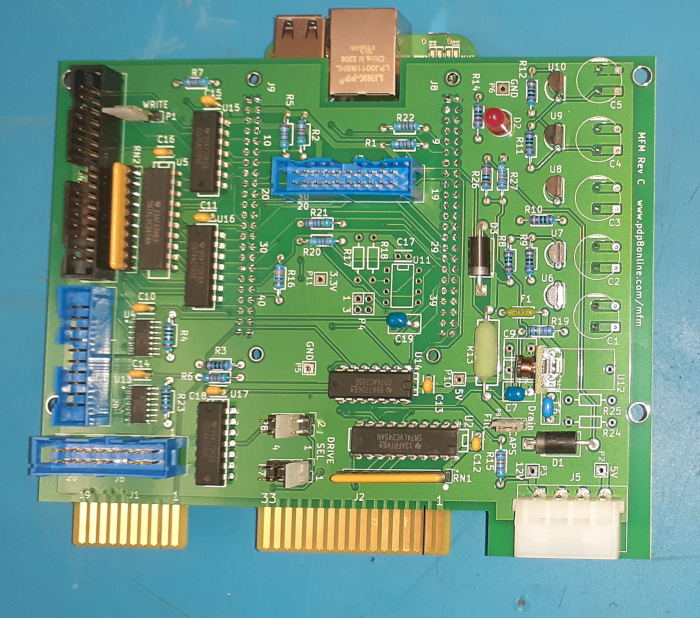
This page has information on the MFM hard disk reader and emulator I have been working on. The unit is intended to read MFM hard drives for archiving and to emulate one or two MFM hard drives to replace failing MFM drives. The image read from a real hard drive can be used for the emulation.
In theory the unit can emulate any MFM hard drive. In practice there are enough variations in how controllers use the drives that software changes have been needed to make it work with some systems. You will need to use a command line to operate the unit for reading disks and to configure it for emulating disks.
It should be able to read and save the raw transition data from most any hard drive using the ST506/ST412 interface. An adapter board is available to allow use with the SA1000 interface used on Shugart SA100# and Quantum Q20#0 8 inch hard drives. This board is used with the MFM board to support those 8" hard drives.
People are still running across formats it can't decode to sector data. For formats that are minor variations adding support doesn't take too long. For some controllers which did their own undocumented thing it can be significant effort to figure out the format. Handling physical to logical translation that some smart controllers did or any file system interpretation is outside the scope of this project.
Writing to real disks is experimental supported.
Manuals: MFM reader usage information, MFM disk emulator usage information, extracted data file to emulator file converter, and Experimental write usage information. You may wish to start with example usage
The board has capacitors to give enough time to cleanly shut down when the host computer is turned off. Instructions for that feature: Power monitor usage information
I disclaim any warranty of merchantability or fitness for a particular purpose. I have been providing support on a time available basis which sometimes means I can't look at your issue for a couple of weeks. I also may not be able to figure out/fix the problem. Some of the issues were only solvable because the person had a logic analyzer and schematics were available for the controller so we could understand what strange things it was doing.
If you're still interested below are the prices.
I have two versions of the OS available for Beaglebone. Let me know which you want if getting Beaglebone from me.
If this doesn't look like what you want there is another unit available from someone else. I have not used this unit. It is somewhat different than mine so verify it does what you want. When I looked at the pages it looked like it couldn't read an existing drive and the controller in your computer needed to be on the supported list for it to work.
Email me at link at bottom of page if interested in purchasing. Send me your address or zip code so I can calculate shipping. If outside USA let me know what country.
For bare boards you will need to order the parts from your distributor of choice.
The assembled boards have all parts installed except U11 and associated parts. For this board where pin function changes based on mode the EEPROM isn't useful do doesn't need to be installed. I have been mounting the capacitors on the bottom. You may request other. This page shows more on the mounting the capacitors.
Forum for discussing this project is here,
The current MFM boards being shipped are revision D. It has the following significant changes: Termination resistors fed through diode to prevent backfeeding power when host computer uses TTL drives. Changed power pads near J5 to match 4 pin floppy power connector pinout.
If you are assembling the first revision of the board shipped in 2014 look at the above first then see the original assembly page. I am no longer updating that page. The current software works with all revisions of the board.
See this page for some historical information on the revision B development
See this page for advanced recovery techniques
Old pages describing start of project